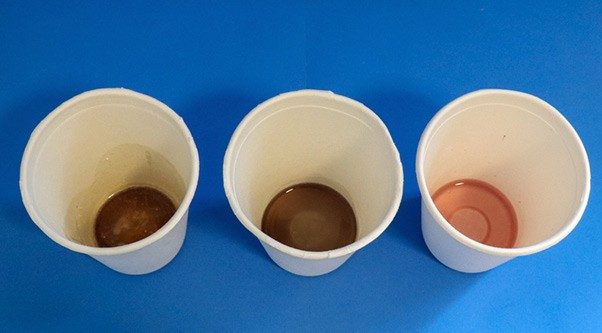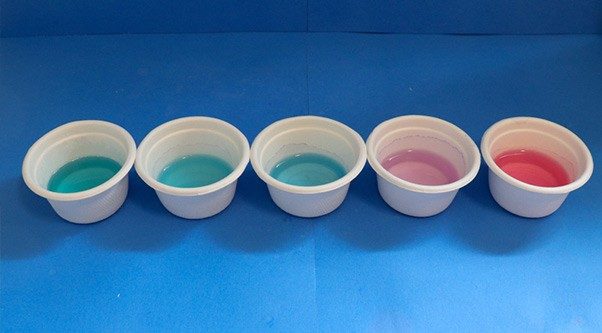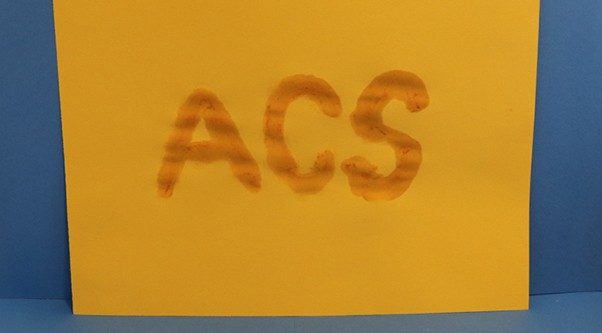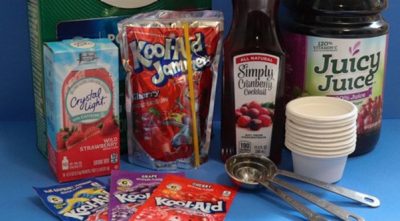
Question to investigate
Which fruit juices contain real fruit and which contain artificial food dyes?
Chemistry concepts
- Acids and bases are classes of materials that have different properties.
- Acid-base indicators change color depending on whether they are in acids or bases.
- Many berry juices contain a substance called anthocyanin that changes color depending on whether mixed with an acid or a base.
Activity logistics
- Ages: As written, this activity is suited for ages 8–12.
- Time: 1–1½ hours
Be safe
- Safety goggles are required.
- Wear a kitchen apron.
- Do not eat or drink any of the materials used in this activity.
- Work with an adult.
- Read and follow all directions for the activity.
- Read all warning labels.
- Wear Personal Protective Equipment (PPE), such as goggles, safety glasses, or gloves.
- Tie back long hair, roll up sleeves, and secure loose clothing.
- Be sure to clean up and dispose of materials properly when you are finished with an activity.
- Wash your hands well before and after the activity
Disposal: Dispose of all solid waste in the trash. The liquids can be safely disposed of down the drain with plenty of water.
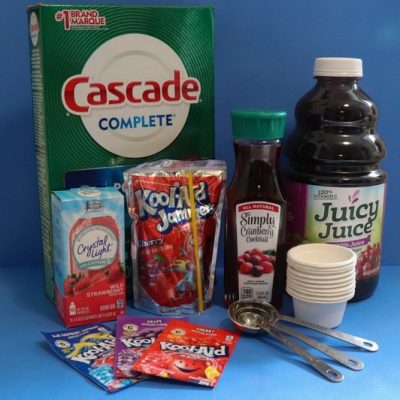
What you’ll need
- Powdered dishwasher detergent
- Several fruit juices to test (include at least one juice labeled as artificial and one as natural). The following fruit juices will work for this activity:
- Cherry
- Grape
- Blackberry
- Strawberry
- Cranberry
- Blueberry
- Measuring spoons
- 3–5 small bowls or small clear glasses
Procedure
- If using powdered drink mixes, mix according to package directions.
- Pour about 1 tbsp. (15 mL) of each beverage into individual small bowls or cups.
- Add ½ tsp. (2.5 mL) of powdered dishwasher detergent or any white cleanser to each bowl. Did any change color? If so, can you describe the change? Fill in your answers in the table below.
- If you have other blue, red, or purple beverages on hand, try them and record your findings in the table in the downloadble PDF.
What did you observe?
Download this worksheet to record your observations.
How does it work?
Chemists classify substances into two main groups—acids and bases. For example, lemons and cranberries are sour — so they are acidic. Bases have a bitter taste and tend to be slimy or slippery. Most soaps are bases. Some substances are neutral, meaning they are neither an acid nor a base, like water.
Real fruit juices often change color if mixed with household acids and bases. Artificial food dyes usually do not change color when mixed with these same household solutions. The colored chemicals in many fruit and berry juices contain a substance called anthocyanin. Anthocyanin is an acid-base indicator, meaning it changes color depending on whether it is mixed with an acid or a base.
Dishwasher detergent is a base. If any of the beverages turned green or blue with the addition of the base, they likely had a significant amount of real fruit juice. If it did not change color, it likely contains a red food dye (like Red #40). It could also have a mixture of dyes, such as Red #40 and Blue #1, or maybe Yellow #6. None of these dyes change color in a base. This experiment will not work for certain fruit juices, like apple juice or orange juice, because apples and oranges do not contain anthocyanin!
This activity is adapted from an activity that originally appeared in the Celebrating Chemistry issue for National Chemistry Week 2016, written by Marilyn Duerst.

